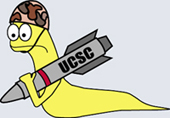
University
of California Shuffling
the Nuclear
|
UC Manages Armageddon: LANL and LLNL Today Today, the three laboratories (including Lawrence Berkeley Laboratory) have a combined UC workforce of 18,000 and operate on federally financed budgets totaling nearly $4 billion.2 Along with nuclear weapons research, LANL and LLNL conduct civilian studies as well, such as energy, space, and medical research. The vast amount of funding, however, given by the Department of Energy to the UC for managment of the labs is used for weapons research. In 2002, LANL recieved 1.2 billion dollars for research and development of nuclear weapons, which was 80% of its entire DOE funding for that year.(5) The budget for 2004 from the DOE for ìtotal weapons activitiesî will be 6.4 billion dollars, an increase of 9% from 2003. 7 This is 30% of the entire annual DOE budget of $21 billion. The $6.4 billion is distributed by the semiautonomous National Nuclear Security Administration, primarily to the three national nuclear labs in the United States: LANL, LLNL, and Sandia National Laboratory in New Mexico which is managed by the Lockheed Martin Corporation. The Los Alamos Laboratory will recieve 1.3 billion dollars for weapons research, Lawrence Livermore will receive 1.2 billion. (6) That means that this year, of the $4 billion dollar combined budget the University of California manages for the labs, $2.5 billion, or 63% will be used for nuclear weapons research. The $2.5 billion is spent on various nuclear weapons programs, including the Stockpile Stewardship Program, which provides for upgrades of every nuclear weapon the US has, and the development of new nuclear weapons, under the guise of stabilizing an already existing arsenal of weaponry. The goal of the SSP is to enhance the capabilities of the US nuclear weapons stockpile. "In that pursuit, NNSA is modifying, altering, refurbishing, performing life extensions on, and replacing life components in all of the weapons in the stockpile."(6) Though a huge portion of the DOEís budget is devoted to these weapons "improvement" programs, the budget contains very little information about them. Also being researched by University of California employees is the Robust Nuclear Earth Penetrator, with a $45 million budget over three years for design and theoretical framework. Construction of the RNEP is set to begin in the spring or summer of 2003 at LANL, and it will be the first new nuclear weapon to be added to the US arsenal since 1989. It has been touted as a more "useable" nuclear weapon, its objective to burrow hundreds of feet below the ground before detonation in a ìbunker-bustingî technique. Not only does preliminary research prove the RNEP ineffective, but it shows that if used in an urban setting, the radiation emitted, though underground, would be enough to kill 50,000 people in the first 24 hours. Bush Administration rhetoric has been heavily saturated with threats of first-strike nuclear use, and the development of a new nuclear weapon designed for battlefield use has disastrous consequences in the international arms control regime. The University of California is responsible for environmental destruction through the development of these weapons. 47,500 barrels of toxic waste from the UC Lawrence Livermore Lab has been dumped off the coast of San Franciscoís Farrellon Islands, the largest fishery on the west coast. The University also cheats local schools out of much needed tax revenue. Both LANL and LLNL pay no state taxes. In New Mexico, LANL would pay an estimated 60 million dollars in state tax, half of which would go to the educational system, however their work is considered ìnonprofit and educationalî by virtue of the fact that it is managed by the University of California.(7) The research of weapons of mass destruction including the RNEP, the management of the Stockpile Stewardship Program, and the disposal of nuclear waste, are all fundamental responsibilities of the University of California as lab managers. Under the guise of fundamental scientific research, backed by one of the nationís most respected institutes of higher learning, laboratory scientists and bureaucrats are able to continue their legacy of building weapons of mass destruction by abusing the reputation of this university, its faculty, and its students.
|
